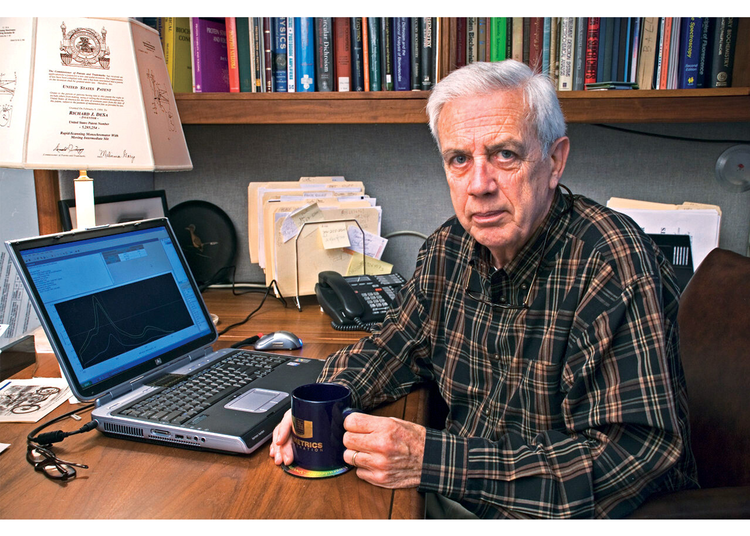Get This Report on Circular Dichroism
Table of ContentsThe 9-Second Trick For SpectrophotometersFascination About Uv/vis/nirUnknown Facts About Circularly Polarized LuminescenceThe Single Strategy To Use For Uv/vis/nirThe Best Guide To Uv/vis/nir

Spectrophotometry is most typically used to ultraviolet, noticeable, and infrared radiation, modern spectrophotometers can question large swaths of the electromagnetic spectrum, including x-ray, ultraviolet, visible, infrared, and/or microwave wavelengths. Spectrophotometry is a tool that hinges on the quantitative analysis of molecules depending on just how much light is soaked up by colored substances.
Some Known Details About Circular Dichroism
A spectrophotometer is typically utilized for the measurement of transmittance or reflectance of services, transparent or nontransparent solids, such as sleek glass, or gases. Although many biochemicals are colored, as in, they absorb noticeable light and for that reason can be determined by colorimetric procedures, even colorless biochemicals can frequently be transformed to colored substances ideal for chromogenic color-forming reactions to yield substances appropriate for colorimetric analysis.: 65 Nevertheless, they can also be designed to determine the diffusivity on any of the noted light varieties that typically cover around 2002500 nm using different controls and calibrations.
An example of an experiment in which spectrophotometry is used is the determination of the equilibrium constant of a solution. A certain chain reaction within an option might happen in a forward and reverse instructions, where reactants form items and products break down into reactants. At some point, this chemical reaction will reach a point of balance called an equilibrium point.
The 9-Minute Rule for Spectrophotometers
The quantity of light that goes through the solution is indicative of the concentration of particular chemicals that do not allow light to travel through. The absorption of light is because of the interaction of light with the electronic and vibrational modes of particles. Each kind of particle has a private set of energy levels related to the makeup of its chemical bonds and nuclei and therefore will take in light of particular wavelengths, or energies, resulting in special spectral residential or commercial properties.
The usage of spectrophotometers spans various clinical fields, such as physics, products science, chemistry, biochemistry. circularly polarized luminescence, chemical engineering, and molecular biology. They are extensively utilized in numerous industries consisting of semiconductors, laser and optical manufacturing, printing and forensic examination, along with in labs for the research study of chemical compounds. Spectrophotometry is typically used in measurements of enzyme activities, determinations of click protein concentrations, determinations of enzymatic kinetic constants, and measurements of ligand binding reactions.: 65 Ultimately, a spectrophotometer has the ability to figure out, depending on the control or calibration, what substances exist in a target and exactly just how much through computations of observed wavelengths.
Invented by Arnold O. Beckman in 1940 [], the spectrophotometer was produced with the help of his colleagues at his company National Technical Laboratories founded in 1935 which would end up being Beckman Instrument Company and ultimately Beckman Coulter. This would come as an option to the formerly developed spectrophotometers which were not able to soak up the ultraviolet properly.
Fascination About Circularly Polarized Luminescence
It would be found that this did not offer satisfying outcomes, therefore in Design B, there was a shift from a glass to a quartz prism which enabled for much better absorbance results - circular dichroism (https://www.cgmimm.com/arts-entertainment/olis-clarity). From there, Design C was born with an adjustment to the wavelength resolution which wound up having three units of it produced
It irradiates the sample with polychromatic light which the sample absorbs depending upon its homes. Then it is sent back by grating the photodiode range which discovers the wavelength area of the spectrum. Considering that then, the creation and execution of spectrophotometry gadgets has increased immensely and has turned into one of the most ingenious instruments of our time.

What Does Circularly Polarized Luminescence Do?
Historically, spectrophotometers use a monochromator including a diffraction grating to produce the analytical spectrum. The grating can either be movable or fixed. If a single detector, such as a photomultiplier tube or photodiode is used, the grating can be scanned stepwise (scanning spectrophotometer) so that the detector can measure the light intensity at each wavelength (which will correspond to each "step").
In such systems, the grating is repaired and the strength of each wavelength of light is measured by a different detector in the selection. When making transmission measurements, the spectrophotometer quantitatively compares the fraction of light that passes through a reference service and a test service, then digitally compares the intensities of the two signals and computes the portion of transmission of the sample compared to the reference standard.
